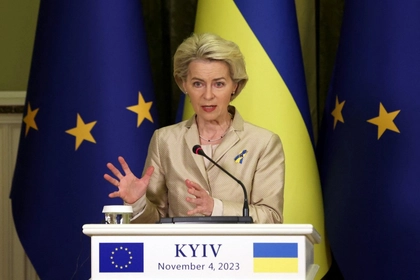According to Politico, citing two U.S. officials involved in the discussions, the Pentagon is thinking about using a fund that has previously been used to provide weapons and equipment over the long term to pay for the Starlink satellite network, which has been a lifeline for Ukraine.
The Ukraine Security Assistance Initiative, which has been used to purchase a variety of weapons and services for the Ukraine war effort, is the most likely source of funding, according to several government and business officials.
JOIN US ON TELEGRAM
Follow our coverage of the war on the @Kyivpost_official.
In relation to the fund, a third official added: “As far as vehicles go, that certainly could be an option.”
Lt. Col. Garron Garn, a Pentagon spokesman, stated, “We don’t have anything to announce today, and I won’t speculate on future security assistance packages.”
The discussion follows CNN’s report on Oct. 14, that SpaceX warned the Pentagon in September that it would no longer be able to afford the satellite terminals and communications services, which have already cost it over $80 million and could cost hundreds of millions more over the next year.
After Russia invaded Ukraine in February, the company offered the use of Starlink terminals out of concern that the nation would be cut off from the outside world. Widespread praise was given to SpaceX for its charitable endeavours.
The U.S. defense department announced on Friday, Oct. 14, that it was still talking with SpaceX about the best course of action. However, it also mentioned that it was looking into other options for commercial satellite communications.

EU Transfers €1.5 Bln Raised From Russian Assets for Ukraine
On Sunday, Oct. 16, a senior Ukrainian diplomat added that Kyiv is still optimistic that a deal can be reached to keep Starlink operating.
Elon Musk is at the centre of the discussion. The founder of SpaceX has recently come under fire for suggesting peace talks in Ukraine that were widely perceived as placating Vladimir Putin. After the CNN report, his comments that he might have to cut off Ukraine’s communications lifeline drew more criticism.
Over the weekend, Musk gave the impression that he was changing his mind about Starlink when he tweeted that the company would still support the service.
“The hell with it … even though Starlink is still losing money & other companies are getting billions of taxpayer $, we’ll just keep funding Ukraine govt for free,” he tweeted.
However, a U.S. official involved in the conversation claimed that there is little faith in Musk’s reliability, forcing the defense department to find a way to maintain Starlink or a suitable backup in Ukraine for the foreseeable future. The official spoke freely about a delicate subject under the condition of anonymity, as did the others who were interviewed for this article.
As nations debated whether to provide funding to ensure Ukrainians’ continued access to the service, the Starlink issue came up during a meeting of the foreign ministers of the European Union on Oct 17.
After the meeting, the foreign policy chief of the EU, Josep Borrell, brought up the idea of paying to maintain the service in Ukraine, but the effort is still in its early stages, according to the Lithuanian Foreign Affairs Minister Gabrielius Landsbergis, who spoke to news outlet Politico.
According to Landsbergis, it should not be up to one “super-powerful” individual to maintain communications for Ukrainian troops in the field: to “wake up one day and say, ‘This is it. This is no longer what I feel like doing.'”
The pipeline for security assistance is intended, in part, to emphasise Washington’s long-term commitment to Kyiv.
The Pentagon disclosed a $1.1 billion package of contracts with the American defense industry in September in order to assemble 18 HIMARS rocket systems, hundreds of armoured vehicles, and radar systems.
On top of the annual funding the program receives, Congress has added $9 billion in emergency funding since May. This includes a new infusion of $3 billion in September for the Pentagon-run account as part of an agreement to fund federal agencies through December.
The funds enable the Pentagon to enter into agreements with the defense sector to produce weapons, ammunition, and equipment for Ukraine. Contrary to early in the conflict, when weapons were taken from military stockpiles and transported to Ukraine, the program is now being used more frequently.
According to a Pentagon official, one way for the process to move forward would be for Ukraine to request the satellite communications equipment through the U.S., just like it does for other military assistance.
You can also highlight the text and press Ctrl + Enter






